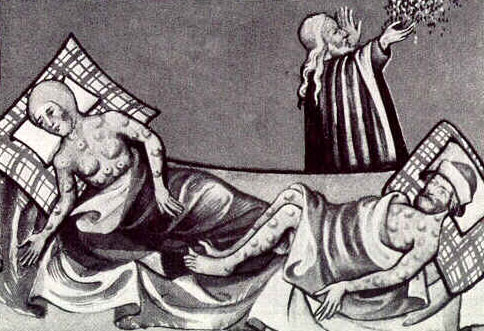How the Black Death Changed the World

Each Monday, this column turns a page in history to explore the discoveries, events and people that continue to affect the history being made today.
Seven thousand people died per day in Cairo. Three-quarters of Florence's residents were buried in makeshift graves in just one macabre year. One third of China evaporated before the rest of the world knew what was coming.
By the time the tornado-like destruction of the 14th-century bubonic plague finally dissipated, nearly half the people in each of the regions it touched had succumbed to a gruesome, painful death.
Related: It Got Better: Life Improved After Black Death, Study Finds
The Black Death – as it is commonly called – especially ravaged Europe, which was halfway through a century already marked by war, famine and scandal in the church, which had moved its headquarters from Rome to Avignon, France, to escape infighting among the cardinals.
In the end, some 75 million people succumbed, it is estimated. It took several centuries for the world's population to recover from the devastation of the plague, but some social changes, borne by watching corpses pile up in the streets, were permanent.
Quick killer
Sign up for the Live Science daily newsletter now
Get the world’s most fascinating discoveries delivered straight to your inbox.
The disease existed in two varieties, one contracted by insect bite and another airborne. In both cases, victims rarely lasted more than three to four days between initial infection and death, a period of intense fever and vomiting during which their lymph nodes swelled uncontrollably and finally burst.
The plague bacteria had lain dormant for hundreds of years before incubating again in the 1320s in the Gobi Desert of Asia, from which it spread quickly in all directions in the blood of fleas that traveled with rodent hosts.
Following very precisely the medieval trade routes from China, through Central Asia and Turkey, the plague finally reached Italy in 1347 aboard a merchant ship whose crew had all already died or been infected by the time it reached port. Densely populated Europe, which had seen a recent growth in the population of its cities, was a tinderbox for the disease.
The Black Death ravaged the continent for three years before it continued on into Russia, killing one-third to one-half of the entire population in ghastly fashion.
The plague killed indiscriminately – young and old, rich and poor – but especially in the cities and among groups who had close contact with the sick. Entire monasteries filled with friars were wiped out and Europe lost most of its doctors. In the countryside, whole villages were abandoned. The disease reached even the isolated outposts of Greenland and Iceland, leaving only wild cattle roaming free without any farmers, according to chroniclers who visited years later.
New landscape
Social effects of the plague were felt immediately after the worst outbreaks petered out. Those who survived benefited from an extreme labor shortage, so serfs once tied to the land now had a choice of whom to work for. Lords had to make conditions better and more attractive or risk leaving their land untended, leading to wage increases across the board.
The taste of better living conditions for the poor would not be forgotten. A few decades later, when lords tried to revert back to the old ways, there were peasant revolts throughout Europe and the lower classes maintained their new freedoms and better pay.
The Catholic Church and Jewish populations in Europe did not fare so well.
Distrust in God and the church, already in poor standing due to recent Papal scandals, grew as people realized that religion could do nothing to stop the spread of the disease and their family's suffering. So many priests died, too, that church services in many areas simply ceased.
Jewish populations, meanwhile, were frequently targeted as scapegoats. In some places, they were accused of poisoning the water because their mortality rates were often significantly lower, something historians have since attributed to better hygiene. This prejudice was nothing new in Europe at the time, but intensified during the Black Death and led many Jews to flee east to Poland and Russia, where they remained in large numbers until the 20th-century.
A study earlier this year found that despite its reputation for indiscriminate destruction, the Black Death targeted the weak, taking a greater toll among those whose immune systems were already compromised.
- Last Week: How the Magna Carta Changed the World
- Next Week: How the Wealthy Medici Changed the World
- Top 10 Mysterious Diseases
- Video: Flu Myths and Truths
Flu: Facts about seasonal influenza and bird flu
What is hantavirus? The rare but deadly respiratory illness spread by rodents











